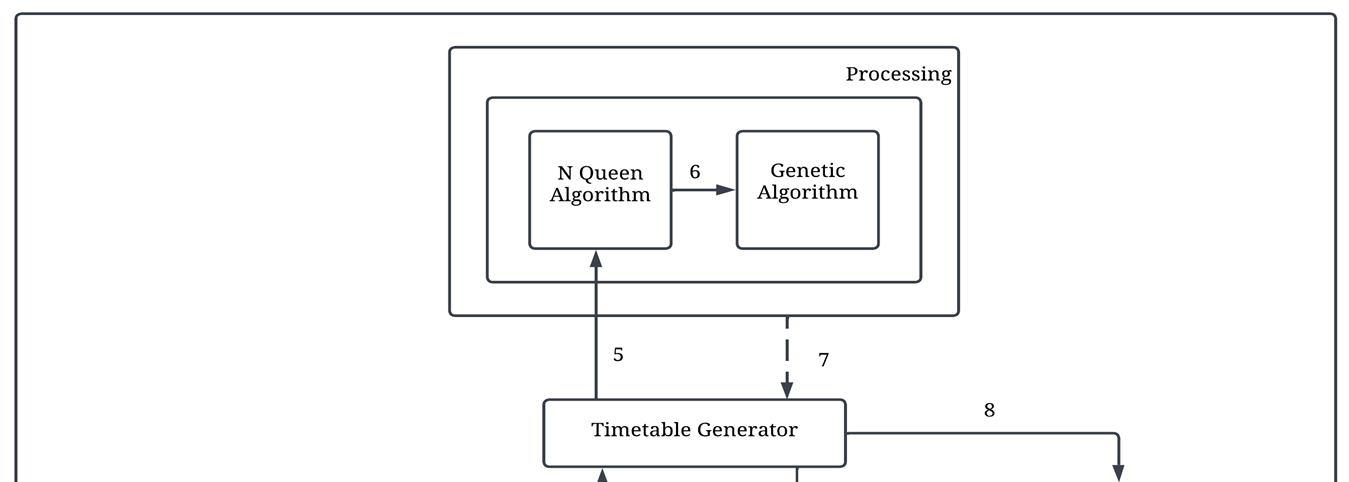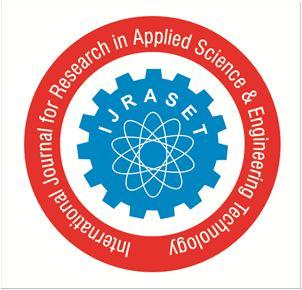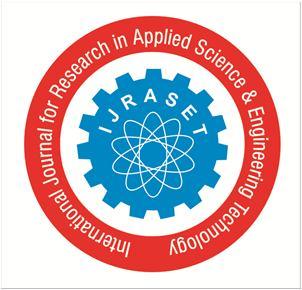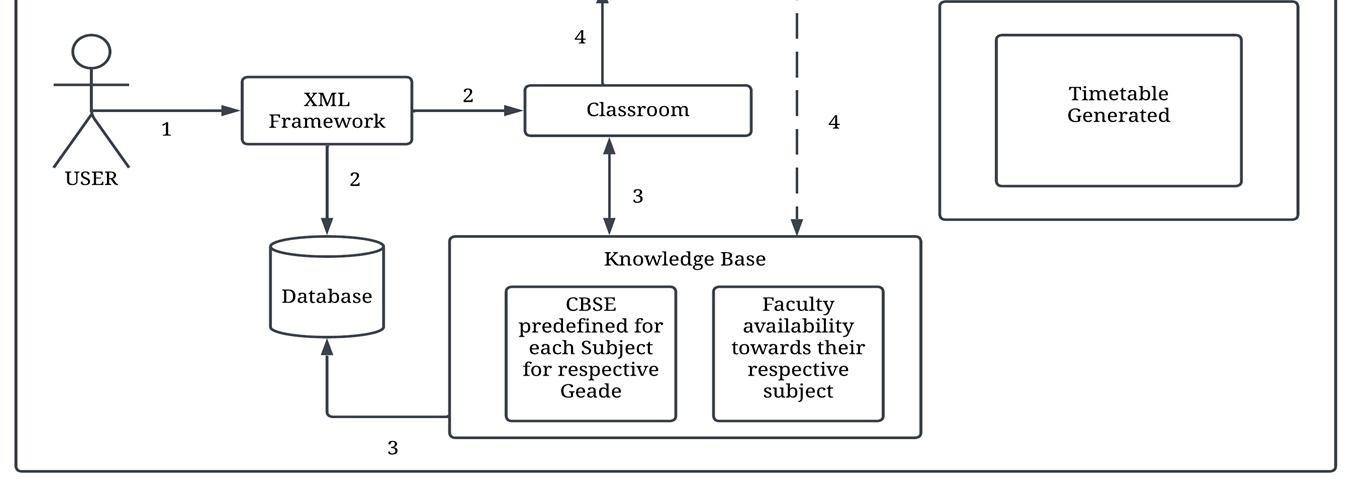
8 minute read
Automatic Timetable Generation
P. Uma1, P. S. Sharvesh2, M. Pradeep3 , P. Sathishkumar4 , R. Senthilnathan5
1Assistant Professor, Computer Science and Engineering, Nanda Engineering College, Erode.
Advertisement

2, 3, 4, 5Student, Computer Science and Engineering, Nanda Engineering College, Erode.
Abstract: Generating a timetable manually for educational institutions can be a tedious task for educators, as each grade has a predefined education scheme and faculty workload that needs to be taken into account. The challenge lies in preparing a timetable that does not overlap with the schedules of the faculty members and can efficiently utilize all available resources. To overcome these difficulties, our project proposes the use of algorithms such as Evolutionary Algorithm, Tabu Search, Simulated Annealing, and scatter search. The proposed system will take inputs such as grade-wise subjects, teachers, and workload, and generate a possible timetable for the working days of the week. The system will integrate these inputs to make optimal use of all resources while adhering to the predefined constraints. This will help overcome the constraints that appear in the manual timetable generation process, resulting in timetables for any number of courses and grades. The implementation of this proposed system will provide a dynamic solution with the best approach, making it easier for educationalists to manage and set timetables. It will eliminate the complexity of manually generating and managing timetables, providing an efficient and effective solution to this challenging task
Keywords: Timetable generation, Evolutionary Algorithm, Optimization, Educational institutions.
I. INTRODUCTION
A timetable is a schedule that outlines the specific times at which certain events are planned to occur. When educationalists manually prepare a timetable, their main task is to ensure the availability and workload of faculty members for each subject. Additionally, they must generate a timetable that adheres to the predefined government scheme for each subject of a particular grade. It is crucial to schedule time slots for each subject smoothly, without any overlap with slots assigned to the same faculty member teaching different grades. To simplify the process of setting and managing timetables, our project proposes a machine learning-based system that takes inputs such as grade-wise subjects, faculty members, and faculty workload. The system will use these inputs to generate a possible timetable for the working days of the week, ensuring optimal use of all available resources. Our suggested solution aims to tackle the limitations inherent in the conventional method of generating timetables, alleviating the monotonous task of manually creating timetables. With the use of machine learning algorithms, this proposed system will eliminate the complexity of manually generating and managing timetables, providing an efficient and effective solution to this challenging task. It will help educationalists prepare timetables in a smooth and streamlined manner, improving the overall efficiency of the educational institution.
II. LITERATURE SURVEY
A literature survey is an essential report that evaluates the information found in literature related to a proposed work. During research, a literature review plays a crucial role as it covers all previous studies on the subject, setting the foundation for the current research. It is a critical part of any report because it provides direction and helps set a goal for analysis. [1] One such proposed work is "Time Table Scheduling using Genetic Artificial Immune Network," which highlights the importance of scheduling in real-life situations such as personnel scheduling, production scheduling, and educational schedule scheduling. [2] Educational schedule scheduling can be particularly challenging due to the various constraints that must be met to achieve a feasible solution. [6] Although Genetic Algorithms (GAs) have been used with mixed success, this work proposes a solution using N Queen algorithmbased approach to solve the heavily constrained Education timetable problem. [3] A review of the scheduling system at our institute revealed the need for a feasible lecture/tutorial timetable for a department, which has been a continuous challenge in educational establishments. [5] The N Queen algorithm-based approach proved to be a useful solution; however, certain issues still need to be addressed. [7] By reviewing existing literature and proposing innovative solutions to existing problems, this work contributes to the advancement of knowledge in the field of educational scheduling. The proposed approach has the potential to simplify and optimize the scheduling process, making it more efficient for educational institutions. [8]
ISSN: 2321-9653; IC Value: 45.98; SJ Impact Factor: 7.538

Volume 11 Issue IV Apr 2023- Available at www.ijraset.com
A. N Queen Algorithm
The Algorithm is the fine chess algorithm of Queen. No two queen can be at its diagonal or straight. This is used to be known as Clash. The objective is to find a solution where each queen is placed in a different row and column. To solve the problem, we start by placing queens one by one in each column, beginning from the leftmost column. After placing a queen in a column, we check for any conflicts with already placed queens. If there is no conflict in the current row, we mark this row and column as part of the solution. However, if we cannot find a row where there is no conflict, we backtrack and try a different row in the same column until we find a solution or return false if there is no solution
B. Genetic Algorithm
The concept of a genetic algorithm is based on the theory of natural evolution proposed by Charles Darwin. In this algorithm, the fittest individuals are selected for reproduction to produce the offspring of the next generation, reflecting the process of survival. The algorithm begins by selecting the fittest individuals from a population, which then produce offspring that inherit the characteristics of their parents and are added to the next generation. If the parents have better fitness, their offspring are more likely to survive and be better than their parents. This iterative process continues until a generation with the fittest individuals is found. This concept can be applied to solve various problems by considering a group of solutions and selecting the set of the best ones
A genetic algorithm typically involves a series of five phases:
Initial population
Fitness function
Selection
Crossover Mutation
1) Initial population: The initial step of the genetic algorithm involves creating a population of potential solutions to the problem being tackled. These solutions are encoded in each member of the population. The fitness function is then used to evaluate and assign a fitness value to each individual in the population. The success of the algorithm depends on the quality of the initial population. A well-constructed and sufficiently large initial population increases the chances of finding a good solution. Conversely, a poorly constructed or inadequate initial population can make it challenging for the algorithm to discover a desirable solution.
2) Selection: The selection operator plays a crucial role in a genetic algorithm, as it determines which chromosomes within the population will be chosen for reproduction. The probability of selection is proportional to the fitness value of each chromosome, so fitter solutions have a higher chance of being selected. This process is repeated during each generation, with a portion of the population being chosen to create a new generation of solutions. The fitness-based selection ensures that the best solutions are more likely to be chosen, increasing the chances of finding an optimal solution to the problem at hand.
3) Crossover: The crossover is a crucial genetic mechanism that is employed to introduce variation into the programming of one or multiple chromosomes between successive generations. It imitates the biological process of reproduction and genetic recombination that underpins genetic algorithms. In a crossover, multiple parent solutions are combined to produce a new child solution. Various techniques can be employed to select the parent chromosomes. During the crossover process, segments of chromosomes before and after a particular locus are randomly exchanged between two parent chromosomes to produce two new offspring chromosomes. Essentially, the crossover operator simulates the natural recombination process that occurs between two individual organisms with a single chromosome.
4) Mutation: In genetic algorithms, mutation is a mechanism to maintain diversity in a population of chromosomes from one generation to another, similar to natural mutation. This process involves altering one or more gene values in a chromosome from its original state. Through mutation, the resulting solution may be significantly different from the previous one, providing opportunities for the algorithm to improve. Typically, mutation occurs at each bit position in a string with a low probability.
5) Fitness function: The fitness function evaluates the quality of a solution represented in the genetic form and measures the level of performance of the represented solution. In fields such as genetic algorithms and genetic programming, each solution is represented in a genetic form, and after each iteration, the objective is to eliminate the 'n' worst solution representations. A solution needs to be assigned a score to indicate how well it met the overall requirement, and this score is generated by applying the fitness function to the test results obtained from that solution.
ISSN: 2321-9653; IC Value: 45.98; SJ Impact Factor: 7.538
Volume 11 Issue IV Apr 2023- Available at www.ijraset.com
III. PROPOSED SYSTEM
Currently, timetables for academic institutions are created manually by faculty members, which can be a time-consuming and challenging task. One of the main responsibilities at the beginning of each academic year is to create a timetable for all grades, considering the availability of faculty members for each subject. However, this can become complex due to various factors such as the education scheme, workload of faculty members, and optimization of resources such as labs and rooms.
To address this issue, an automated system can be developed to generate timetables for all grades based on predefined education schemes and the availability of faculty members. This system will optimize resources by generating possible timetables for teaching faculty, taking into account the constraints of working days of the week. With this approach, the system will save time and effort for institute administration.
A. Constraints
1) Each subject has a predefined education scheme.
2) Faculty members’ workload is taken into consideration.
3) No slot clashes should occur for a faculty member.
4) Priority is given to scheduling practical slots followed by tutorial slots.
5) Labs are provided for tutorials, if required.

Creating a timetable for each grade at the beginning of every academic year is a complex challenge that requires taking into account the availability of faculty members across all grades. The manual process of creating timetables can be time-consuming for faculty members. Therefore, an automated system can help to save time and energy for institute administration. The automated timetable generator will work for all grades and optimize the use of available resources, including faculty members, labs, and rooms. By taking into account the predefined education scheme for each subject and the workload of faculty members, the system will generate feasible timetables for the working days of the week. It will ensure that practical slots are given priority, followed by tutorial slots, and will allocate labs for tutorials when needed. Overall, the system will make optimal use of resources to meet the scheduling constraints.
Fig. 1. Proposed system
Each faculty member is required to register themselves on the portal using their unique faculty identification number or employee identification number. The system will then take inputs such as branch, division, grade, number of subjects, and workload of the faculty member. To ensure slot availability for a particular subject in a grade, the system follows specific rules and constraints stored in its knowledge base, providing all possible slots. Our project uses algorithms that streamline the process of generating timetables, employing various strategies to optimize resources and minimize difficulties.






